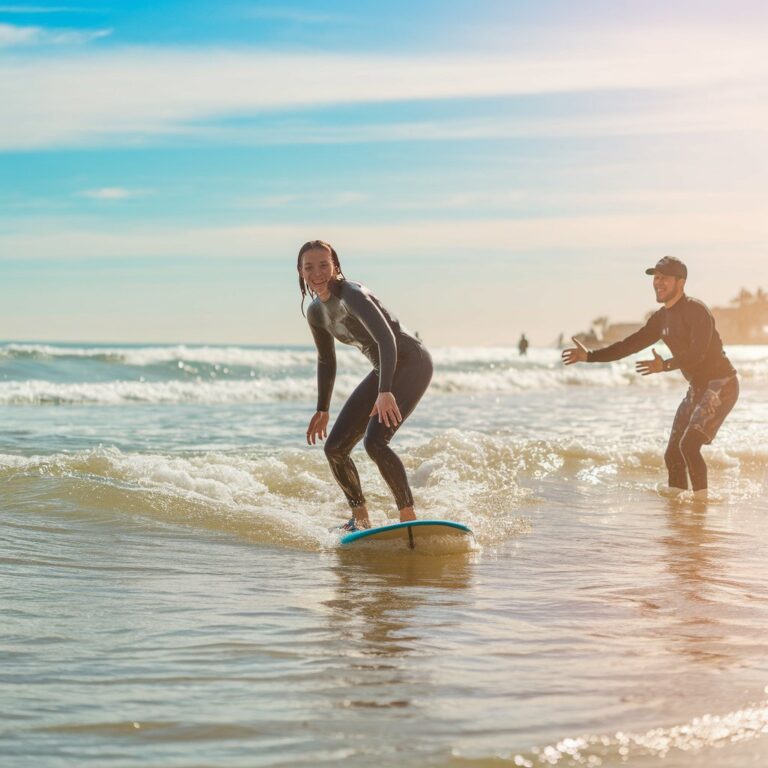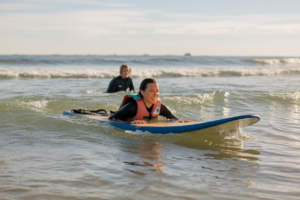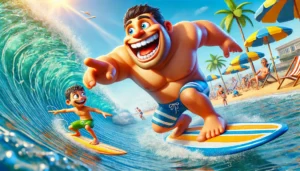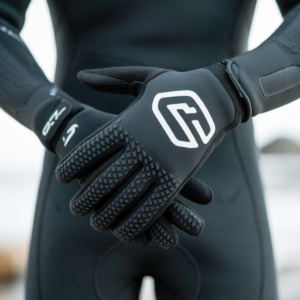Learning to surf is challenging for everyone but I think it is one of the most enjoyable sports on the planet. If you are thinking about trying surfing for the first time, just do it!
Don’t use your age as an excuse to hold you back from chasing your dreams.
Just the other day I had someone ask me, “Is it too late to learn to surf in my 20’s?”
I actually get that question a lot so I did some research.
Learning to surf in your 20’s will take focus and determination but you’re never too old to start! Surfers can progress quickly in their 20’s if they immerse themselves in the process, including, taking lessons, improving fitness, finding like minded people and having fun!
I surfed a lot in my 20’s and it is an optimal time in your life to embark on a new adventure and dedicate yourself to learning a new skill.
Stoke Your Passion
The most popular quote in surfing is “The best surfer is the one having the most fun”
As a surfer, having fun should be your number one goal.
When I first started surfing, I wanted to surf all the time. I loved surfing with friends and going on multi-day camping trips to different beaches.
As my skills progressed, I enjoyed travelling internationally, experiencing different cultures and surfing in different countries.
Nowadays, I am quite happy just showing up at a beach and surfing with a bunch of surfers I don’t know.
Put simply, find out what you love about surfing and do as much of that as possible.
Surfing lessons: fast track your learning
Learning to surf can be a daunting task when you are first starting out. The quickest way to learn the surfing basics is to take a lesson.
Before you go to the beach for the first time, you will learn how to put on a wetsuit and choose an appropriately sized surfboard.
Once you are at the beach, most instructors will start you out on the sand where you will learn about ocean safety and the proper technique to position yourself in the water, paddle, pop up to a standing position and ride waves.
In the water, the fun begins! You will have an opportunity to ride waves in a fun, safe environment with a bunch of people that are stoked about surfing.
Some people look down on the suggestion of taking lessons, but I think lessons help build confidence and create an encouraging environment for beginner surfers.
Take as many lessons as you need to get the basics under your belt. Some surfers will book a series of lessons or sign up for a week long surf camp, which can really elevate your skills quickly.
For more info about surfing lessons, read this article: Are Surf Lessons Worth It? 11 Reasons Why
How To Choose a Beginner Surfboard
The biggest mistake in surfing is riding a board that is too small.
This is a mistake that every surfer makes over and over again throughout their surfing career.
In my opinion, the problem has been created by the surfing industry.
The surfing industry spends millions of dollars every year to market surfboards that won’t work for the average surfer. The surfboards you will see in most of the advertisements are light weight, finely tuned and difficult to surf because they have been designed for professional surfers.
But the message that “smaller is better” makes most surfers think that we should be riding shorter, skinnier surfboards, which just isn’t true.
Bigger surfboards will float better and help you catch more waves. Don’t feel like you need to ride a small surfboard because that’s what the professionals ride.
Even when you advance from a beginner to an intermediate and beyond, you will still have fun riding a big surfboard.
If you are looking for more information about how to select the right surfboard, click on the link to check out my article titled, Beginner Foam Surfboards: A Helpful Buyers Guide.
Learn to read the waves and the line up
As a surfer, you will like some surf breaks better than others.
A surf break is a permanent area of the ocean where surfable waves break over a reef, rock or sand bottom. There can be multiple different surf breaks at one beach.
For example, the North Shore of Oahu, Hawaii is one of the most famous stretches of surf breaks in the world. It is called the 7 Mile Miracle because there are over 35 surf breaks in a relatively small stretch of coastline.
Surfers spend hours watching the waves break and studying the ocean in an effort to learn all the little tricks of a spot like where to catch the best waves, how to stay safe and how to avoid getting in the way of other surfers.
For beginners, it is best to start out surfing at beginner friendly surf breaks, which usually have smaller waves and lots of other beginner surfers in the water. So start studying the break in your area and find a spot that aligns with your skill level.
Talk to other surfers or ask the folks at the surf shop. If you are taking a lesson, you will most likely be surfing at a beginner friendly spot so that will be a good place to start.
Move to a Surf Town
As a beginner surfer, you will progress quicker if you immerse yourself in the sport of surfing.
A great way to get immersed in the surfing culture and meet like minded people is to get a job in a surf town. A surf town is a community located near the beach where surfing is the number one activity and there is a large population of surfers.
In Western Canada where I live, Tofino is the most popular surfing town and is actually considered to be the surfing capital of Canada.
Just south of Tofino there is a 20 km (12 miles) stretch of sandy beaches with 8-10 different surf breaks. It is one of the most beautiful stretches of coastline in the country and tourists and locals flock to the beaches all year round.
There are lots of different employment options for surfers in their 20’s, including surf shops, surf schools, hotels, coffee shops and restaurants.
If you live in the United States, there are dozens of great surf towns in the country. According to Surfer Magazine, the best surfing town in the United States is located in Hawaii and 5 of the top 10 locations are located in California.
Surf Wetsuit: Necessary or not?
If you have tried surfing a few times and gone through the wetsuit rental process then you might be ready to invest in your own wetsuit.
Make sure you know what size fits you best and what style and thickness will keep you warm. If you are always cold then you won’t be motivated to go surfing.
If you own your own wetsuit it will make the preparation more efficient because you can just grab a surfboard and go straight to the beach.
Personally, I borrowed or rented wetsuits for about 15-20 times before I bought my first wetsuit. I purchased a Hotline Wetsuit in 1997 and it was the best! I was warm and comfortable and it allowed me to spend countless hours in the ocean chasing waves.
If you are looking for more information about how to choose a wetsuit, click on the link to check out my article titled, The Complete Beginners Guide To Buying a New Surf Wetsuit.
Surf to Improve Your Fitness: Myth or Reality?
Surfing is a sport that becomes easier if you improve your fitness.
No matter what fitness level you are starting at, every minor increment of improvement will translate positively to your surfing experience.
Effective cross training activities that will help your surfing include Yoga, resistance training, running, biking and swimming.
If you are looking for some effective tips to get in shape, click on the link to be redirected to my blog post titled, Surfing & Weight Loss: 10 Tips to Help Surfers Get in Shape.
In Conclusion:
From a fitness point of view, your 20’s is a decade of discovery and adventure and it is one of the best times in life to learn the sport of surfing.
By taking lessons, making friends, improving fitness and immersing yourself in the surfing culture, you will progress quickly and find your passion.
Go surfing, have fun, repeat!
FAQs:
How to get into surfing?
Getting into surfing is all about starting with the right equipment and practicing in beginner-friendly conditions.
A soft-top surfboard and lessons from a local surf school will help you get comfortable with the basics like paddling, popping up, and balancing.
Choose easy waves at beaches where conditions are ideal for learning. As you progress, focus on building strength, observing more experienced surfers, and understanding surf etiquette to enhance your experience in the water.
Patience and consistency are key, but with regular practice, you’ll soon catch your first waves with confidence.
How long does it take to get good at surfing?
Learning to surf varies from person to person, but most beginners can catch small waves and stand up on the board after a few lessons.
With regular practice, it usually takes a few weeks to develop basic skills like paddling, timing, and balance.
Progress depends on factors like your fitness level, how often you surf, and the conditions you practice in.
The key is to stay consistent and patient. Surfing is a challenging but rewarding sport that gets easier the more time you spend in the water.
How to get good at surfing?
To get good at surfing, consistency is key. Spending as much time in the water as possible will help you improve faster.
Focus on refining the basics like paddling, wave timing, and balance, and gradually challenge yourself with bigger waves.
Watching experienced surfers, understanding ocean conditions, and learning surf etiquette will also enhance your skills.
Cross-training with activities like swimming, yoga, and strength exercises can improve your fitness and flexibility, making it easier to progress.
Patience is important—surfing is a gradual learning process, but regular practice will lead to steady improvement.
Do I need to be a strong swimmer to start surfing?
Being a strong swimmer is important for surfing, as you’ll need to feel comfortable in the ocean.
But the most important thing is to know your limits: only go out in conditions suitable to your skill level. Safety comes first.
If you’re not sure, ask a more experienced surfer if its safe for you to go surfing.
Regular practice will dramatically improve your swimming skills and confidence. So don’t worry too much if you’re not the best swimmer to start with.




